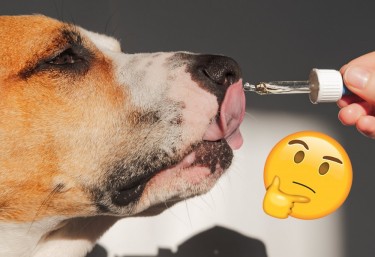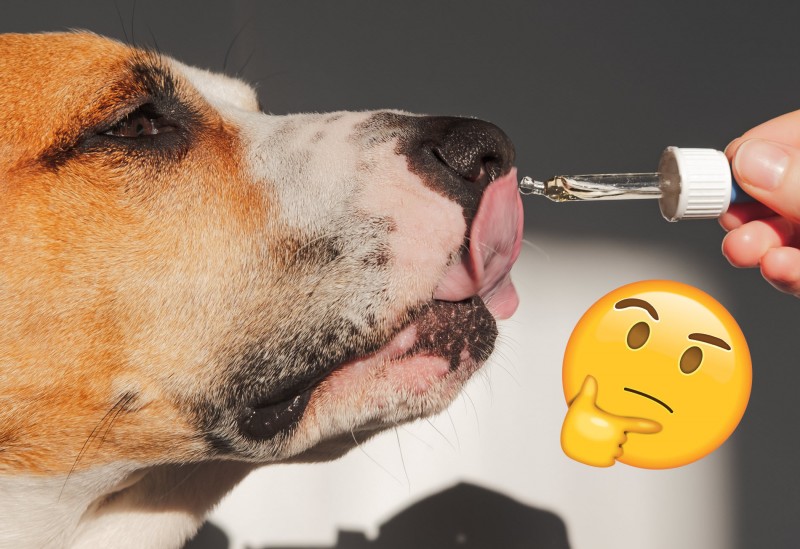As the Popularity of CBD Oil for Dogs Continues to Grow, So Do the Scams

The supplement industry is rife with unsupported health claims, mysterious ingredients lists, and trending controversies. As most wellness products are unregulated by the FDA, the market can be a bit of a wild west for consumers, who are pretty much left to rely on their own wits and research.
Over the past year, we’ve talked to dog owners, read enough studies to melt our eyes, and kept up to date with the lead edge of cannabis research. All of which allows us to say confidently that CBD for dogs does indeed work—with some caveats. Here’s what we found.
CBD is a legit, bioactive compound
When properly made (extracted from organic hemp and combined with a safe carrier oil), CBD is both safe and legal to consume in the US. Studies on CBD’s toxicity suggest that ill-effects only begin to occur at super-high concentrations of more than one hundred times the recommended amount which is generally 0.2 to 0.5 mg per pound of body weight.
Since the 2018 amendments to the federal Farm Bill, industrial hemp used to manufacture pet CBD can also be lawfully grown, sold, and bought across state lines, so there’s no need to worry about the legalities of giving your pet hemp-derived products.
Finally, repeated use and study of CBD in humans shows a clear bioactive effect in the vast majority of situations. Like all cannabinoid compounds from the cannabis plant, CBD is able to influence the endocannabinoid system, which is a key regulator of inflammation and homeostasis found in humans, dogs, mice, and pretty much all mammals. While extensive studies have not been done, anecdotal evidence of CBD oil for dogs suggests potential in the oil.
But not all CBD products are created equal
While CBD itself is safe for dogs to consume, the booming CBD industry has spawned its fair share of bad actors and shady retailers, offering products that don’t match up to owner expectations. As a consumer, there are a few things you can do to make sure your dog is only consuming the best CBD items:
Look for CO2 extraction. When it comes to extracting CBD from hemp plants, it’s the quality rather than the type of method that really counts. But of all extraction types, CO2 is generally considered the safest and most professional method.
Always choose CBD made from hemp. By law, Industrial Hemp must have less than 0.3 percent THC content, which means that it cannot get your dog high. As a result, the majority of CBD pet products will be made from hemp plants—but there are a minority of non-hemp CBD oils out there. While CBD made from other types of cannabis may be safe for your dog to consume, we don’t recommend taking the risk.
Never buy CBD from Amazon. Despite thousands of search results appearing under ‘CBD for dogs’ on its marketplace, Amazon officially bans the sale of CBD products on its site. Because of this, it’s not possible to verify the legitimacy of products sold through Amazon.
There aren’t many studies on dogs, but those that do exist are promising
The ethics of running tests on dogs, as well as traditional scientific procedures, means that studies using CBD on dogs are thin on the ground. However, that’s not to say that science doesn’t exist in this area. Researchers have tested the effects of CBD on dogs for a range of conditions, including osteoarthritis and seizures—two of the most common issues affecting today’s pups.
In studies on both of these disorders, dogs taking CBD orally and topically showed marked symptom improvements, with one study on arthritis recorded positive effects for two weeks after CBD treatment was stopped!
Looking more widely, there are numerous clinical trials involving the use of CBD on humans and mice, which overwhelmingly stack in favor of CBDs’ ability to suppress inflammation, prevent seizures, and more. In fact, a CBD product for alleviating seizures remains one of the only FDA-approved uses for cannabis supplements.
Dogs aren’t great at communicating discomfort
While the science and anecdotal evidence for CBD and dogs is definitely there, knowing when to use CBD on your dog—and telling whether or not it’s working—can be a different story.
As a species, dogs are apt to hide feelings of pain and discomfort for as long as they can, only showing symptoms such as whimpering or limping when conditions have significantly progressed. Many experts believe this behavior can be traced back to a wolf pack mentality, where an injured wolf may be considered a risk by other members of the pack.
Whatever the reasons behind their behavior, dogs’ reluctance to communicate discomfort means that CBD’s effects can be subtle and easy to miss. While you’re likely to notice a reduction in seizures or severe anxiety, many owners have reported only slight increases in mobility or decreases in visible stress. Some report nothing at all.
CBD will work for most, but not all dogs
All dogs have endocannabinoid systems, but like humans, some pups just don’t seem to be affected by CBD, regardless of the correct dosage. The reasons behind this are unclear, reflecting the fact that research on cannabis and its effects on the body is still very much in its infancy.
CBD also won’t work in the same way for every dog. Some owners claim that to have seen CBD take effect in as little as twenty minutes after a dog’s first dose. More likely, however, is that benefits become visible after around a week of steady consistent treatment with CBD.







